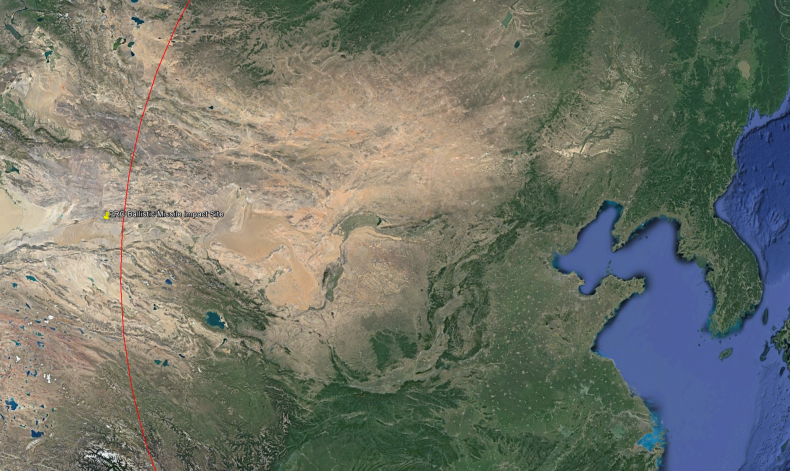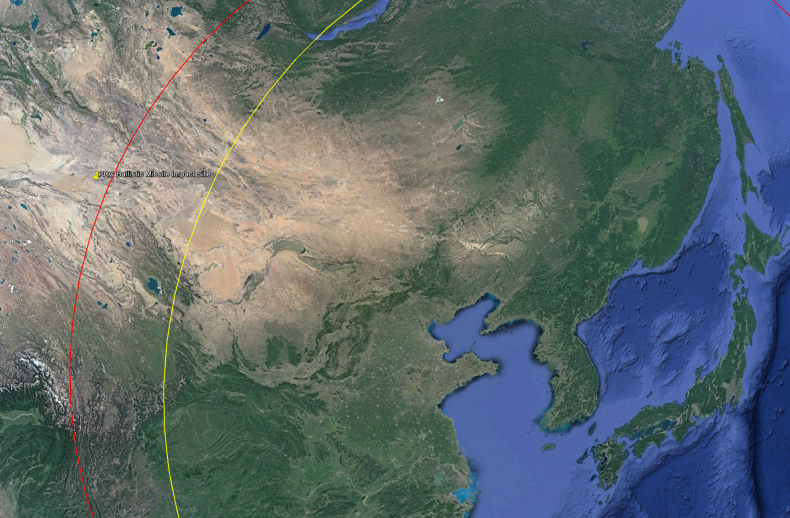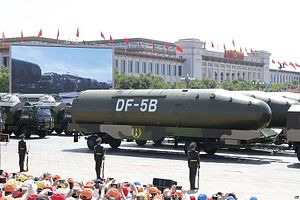Earlier this week, hours after North Korea’s launch of a four-missile salvo into the Sea of Japan, the United States delivered and began deployment of part of the Terminal High-Altitude Area Defense (THAAD) system. “Continued provocative actions by North Korea, to include yesterday’s launch of multiple missiles, only confirm the prudence of our alliance decision last year to deploy THAAD to South Korea,” said the head of U.S. Pacific Command, Admiral Harry Harris, underlining the rationale behind the decision.
China, South Korea’s neighbor and the United States’ great power competitor in Asia, has long been vocally opposed to the deployment of THAAD on the Korean peninsula. In response to the deployment, Geng Shuang, a Chinese foreign ministry spokesperson, noted that China was “resolutely against the deployment of THAAD by the US and the ROK in the ROK, and will take firm and necessary steps to safeguard our security interests.”
For starters, let’s put to rest the misconception that China’s opposition to the THAAD deployment is because it is worried about the interceptor shooting down its missiles. As the ‘T’ indicates in THAAD, the system is only capable of intercepting projectiles in their “terminal” phase (or as they’re hurtling towards the earth in descent). Unless China would consider firing ballistic missiles at South Korea, THAAD will do no good against its missiles (say, it’s intercontinental ballistic missiles going toward the United States in a nuclear exchange).
For China, opposition to THAAD is simple: it’s all about the X-band AN/TPY-2 radar unit that accompanies the interceptor battery and aids in targeting. The radar unit has yet to be delivered; it is expected to arrive in South Korea in April.
To be clear, China hasn’t been coy about specifically pointing to the radar issue. In fact, it has been explicit. Chinese Foreign Minister Wang Yi has made multiple references to the “X-band radar” that accompanies the THAAD battery, pointing out last February that it “goes far beyond the defense need of the Korean Peninsula.” This isn’t a case of Beijing nebulously stating its opposing to the deployment in terms of its national interest.
However, by that same token, China has turned down good faith offers from the United States for technical talks and consultations on the THAAD deployment in South Korea. The Obama administration, looking to assure China that the deployment wasn’t all a ruse to hurt China’s interests, invited Beijing to talks as early as a year ago. “We will be very glad and hope we’ll have the opportunity to sit down and talk with China about those very technical limitations and facts about the system,” Rose Gottemoeller, the former undersecretary of State for Arms Control and International Security, had said at the time. China rebuffed those offers. Chinese Foreign Ministry spokeswoman Hua Chunying noted last year that THAAD was “certainly not a simple technology issue” for China.
So, what is it about THAAD — specifically about the X-band AN/TPY-2 radar accompanying the battery in South Korea — that so vexes China? What is it about this radar that drove Beijing to initiate a thorough dismantling of a slowly-but-surely improving bilateral relationship with South Korea through 2015 and early-2016?
Two Competing Hypotheses
There are two possible serious explanations for how THAAD infringes on Chinese national interests. One is less convincing than the other. I’ll address both in order, beginning with the less convincing explanation.
The first hypothesis is that China may fear that the AN/TPY-2 radar at the former Lotte Group golf course in Gyeongsangbuk-do will give the United States unprecedented surveillance insight into sensitive Chinese missile testing and development work deep within the mainland.
This may sound convincing at first glance, but there’s a few reasons why it doesn’t hold water. First, the South Korean THAAD deployment is not the first AN/TPY-2 deployment from the United States; nor is it even the first deployment of an advanced radar by the United States to the region. The U.S. already has two AN/TPY-2 installations in Japan, at the Kyogamisaki Communications Site in Kyoto prefecture and Shariki in Aomori prefecture.
Second, while we have no watertight estimates on just how capable the AN/TPY-2 radar is and in what configurations, even the most generous estimates don’t leave the Gyeongsangbuk-do unit capable of any useful surveillance deep into the Gobi desert, where China has its most active and sensitive missile testing ranges. (AN/TPY-2 range estimates go from “several hundred miles” to 3,000 km.) I’ve mapped out the ranges below with the most generous range estimate of 3,000 km, using a Chinese ballistic missile impact range that Thomas Shugart at War on the Rocks recently revealed as a test-bed for potential People’s Liberation Army Rocket Force preempetive warfare tactics (i.e., a site of surveillance interest for the United States).

Red line represents 3,000 km range perimeter for a Gyeongsangbuk-do AN/TPY-2 radar, based off the greatest range estimates for the system. Source: Google Earth
Adding the westernmost AN/TPY-2 in Japan — the Kyogamisaki Communications Site unit — the map doesn’t change drastically, either. (Incidentally, North Korea’s latest missile test resulted in three missiles splashing down in Japan’s exclusive economic zone, between the two AN/TPY-2s in the country — a less-than-subtle show of confidence.)

Red line represents 3,000 km range perimeter for a Gyeongsangbuk-do AN/TPY-2 radar, based off the greatest range estimates for the system. Yellow line represents 3,000 km range estimate for a Kyogamisaki Communications Site AN/TPY-2 radar. Source: Google Earth
Basically, the surveillance explanation doesn’t appear to be terribly convincing here. The United States additionally has an older PAVE PAWS installation in Taiwan that adds to its long-range radar capabilities in the region. Given these existing capabilities, the Gyeongsangbuk-do THAAD battery and its accompanying radar won’t give the United States a new and potent looking glass into China that it doesn’t already possess.
The second hypothesis is, I think, more convincing, and one where Beijing may have legitimate concern about the Gyeongsangbuk-do AN/TPY-2 radar upsetting U.S.-China strategic nuclear stability. Specifically, China may — correctly or incorrectly — fear that its nuclear second-strike capability is significantly degraded as a result of a third U.S. AN/TPY-2 radar going up specifically near the southern tip of the Korean peninsula.
To avoid the need for a massive nuclear build-up and to feel comfortable with its several hundred or so nuclear warheads for targeting, China needs to feel comfortable enough its intercontinental ballistic missiles can reliably penetrate U.S. antiballistic missile countermeasures. Pre-THAAD-in-South-Korea, a Chinese ICBM launch would still have been exposed to the AN/TPY-2s in Japan, but that exposure alone wouldn’t have been enough to reliably help U.S. ground-based interceptors (GBI) in Alaska get a convincing edge against incoming Chinese warheads. (Set aside GBI’s patchy success record for the moment.)
With a third AN/TPY-2 in South Korea, the resolution of U.S. data on incoming Chinese warheads would potentially be greatly enhanced. Specifically, China may fear that penetration aids for its ICBMs — such as decoy warheads — would be degraded, lowering the certitude that its existing arsenal would be sufficient for penetrating past the U.S. ABM apparatus. Theoretically, a triangulated AN/TPY-2 setup between Japan and South Korea could give U.S. midcourse interceptors in Alaska enough warning to have a better shot at an incoming Chinese missile.
Moreover, specifically, a Gyeongsangbuk-do-based AN/TPY-2 would also potentially have a unique vantage point for differentiating real warheads from decoys. Li Bin, writing for the Kyunghyang Daily, outlines this case in greater detail: “The THAAD radar to be deployed in the ROK would be in a very special position where it could view the back of the Chinese warheads flying over the northeast part of China when it is deployed to watch missiles from North Korea.”
Li’s proposed solution for the United States was simple enough: the United States could “deploy its Green Pine radar or another radar with similar capabilities to guide the THAAD interceptors.” Li add that the “THAAD TPY-2 radar does not provide more capability to protect the ROK from the North Korean missile threat relative to a Green Pine-level radar since the TPY-2 radar’s detection range goes too far beyond North Korean territory.” It’s unclear also if a Green Pine radar would synergize with the existing AN/TPY-2s in Japan.
Instability and Insecurity
Even without entering technical talks with the United States on THAAD, it’s possible that Chinese strategic planners are all-but-certain that the AN/TPY-2 at Gyeongsangbuk-do will severely degrade their confidence in their nuclear second-strike capability. That explains why Beijing’s been so vocally opposed to the deployment, why it is dismantling all bilateral momentum with South Korea, and why it shows no signs of budging. In fact, given that many analysts also speculate that China’s recent foray into multiple independently targetable reentry vehicle (MIRV) capable ballistic missiles was primarily based around increasing penetration aids, Beijing may see the U.S.-South Korea move as effectively nullifying its investment.
It’s unclear how China will choose to maneuver from here if the second hypothesis — insecurity about the status of its second-strike — is what’s driving its opposition to THAAD. One solution could be to engage in a massive build-up of its warhead and ballistic missile stockpiles. China’s existing arsenal is far more modest than the Soviet Union at the height of its Cold War nuclear rivalry with the United States and remarkably asymmetrical with existing U.S. stockpiles.
Interestingly, it is possible that Chinese concerns could have been somewhat assuaged if the Obama administration had moved forward with a declaration of a formal no-first-use doctrine for the U.S. nuclear arsenal. China has repeatedly affirmed its own no-first-use doctrine and some of its concern over second-strike degradation may have been assuaged over this. Of course, with the Trump administration in the White House and determined to ensure that the U.S. “expand its nuclear capability,” this now seems like far from a realistic proposal. Moreover, given the declaratory nature of doctrinal pronouncement, Beijing would still look to shore-up its second-strike capability.
China’s best option, however, simply may be South Korean domestic politics. Moon Jae-in of the Minjoo Party appears to be in a strong position as South Korea’s next election approaches later this year. Moon and his party have vocally opposed THAAD, but Moon changed his tone recently, saying that he didn’t think it would be “easy to cancel the agreement which has already been made between Korea and the United States.” Nevertheless, more so than now-disgraced former President Park Geun-hye, Moon, if elected, may be open to a pragmatic quid pro quo arrangement with China to reverse the deployment of THAAD.
China has invested considerable diplomatic capital in opposing the deployment and it remains to be seen how it will choose to handle the situation once the battery and radar are fully operational. Meanwhile, North Korea shows no sign of abating its ballistic missile testing, which serves to simply underline the point the United States and South Korea have long made in favor of the deployment: it’s necessary to defend South Korea. Whatever comes next, the THAAD saga on the Korean peninsula is certainly far from over.
Ankit Panda is a senior editor at The Diplomat, where he writes on international security, economics, and politics. He tweets at @nktpnd.
































